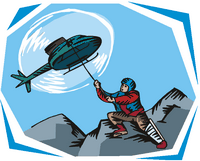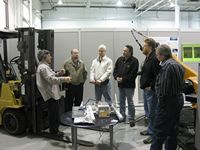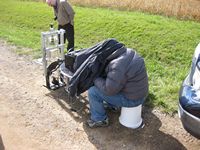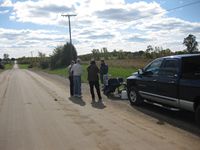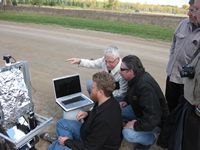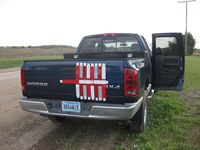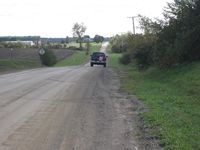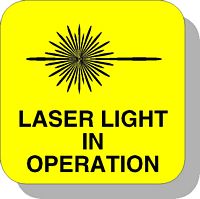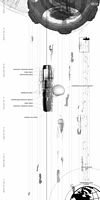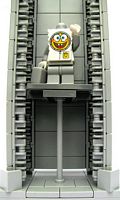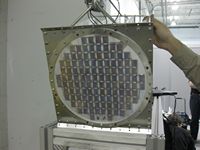 All in all, a pretty good day, I think. The NSS team came here to qualify their optical system and Climber with a TRUMPF laser. Three tests were run today. There were two successes and one “I don’t know yet” results.
All in all, a pretty good day, I think. The NSS team came here to qualify their optical system and Climber with a TRUMPF laser. Three tests were run today. There were two successes and one “I don’t know yet” results.
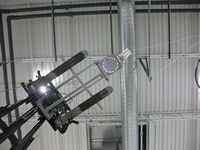 Several members of the NSS team were here, along with Ben Shelef (CEO of Spaceward, the organizer of the Games), John Piatt (from NASA – making sure that the equipment met not only Spaceward’s standards, but NASAs too. John gets ‘special points’ – a government employee coming here on a Federal holiday – thanks John!), Nic DeGrazia (chief filmographer from Chicago video production company Bitter Jester Creative Inc., the team filming the entire Space Elevator Games story) and yours truly.
Several members of the NSS team were here, along with Ben Shelef (CEO of Spaceward, the organizer of the Games), John Piatt (from NASA – making sure that the equipment met not only Spaceward’s standards, but NASAs too. John gets ‘special points’ – a government employee coming here on a Federal holiday – thanks John!), Nic DeGrazia (chief filmographer from Chicago video production company Bitter Jester Creative Inc., the team filming the entire Space Elevator Games story) and yours truly.
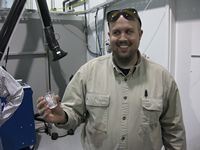 Some members of the NSS team left yesterday and are being replaced with others today.
Some members of the NSS team left yesterday and are being replaced with others today.
The first test was a reflectivity test, making sure that the Climber did not reflect any of the laser beam back in a dangerous or uncontrolled manner. The climber was mounted on an aluminum rack, held aloft by a forklift truck. The TRUMPF laser was directed onto a mirror and then onto the bottom side of the climber. Both Ben and John then examined the results to ensure that no untoward reflections were being created and, I’m happy to say, no issues were uncovered. Test 1 – Pass.
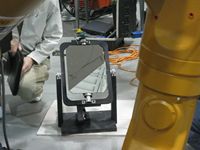 The second test was much more fun and consisted of trying to melt the Climber – i.e., this was a test which directed the full power of the laser at the bottom of the climber in order to determine if it could really handle the expected load over the expected run time of a competition climb. NSS uses a very novel heat dissipation system – a liquid cooled one. Over the top of the solar cells, they have created a (mostly) liquid-tight reservoir which holds several ounces of Acetone. The top of the reservoir opens up into 5 plastic bags. The theory behind this design is that the heat from the laser would boil the acetone, turning it into vapor. This vapor would then ascend upwards to the top of the plastic bags, cool, condense, and then run back down into the reservoir so the cycle could restart.
The second test was much more fun and consisted of trying to melt the Climber – i.e., this was a test which directed the full power of the laser at the bottom of the climber in order to determine if it could really handle the expected load over the expected run time of a competition climb. NSS uses a very novel heat dissipation system – a liquid cooled one. Over the top of the solar cells, they have created a (mostly) liquid-tight reservoir which holds several ounces of Acetone. The top of the reservoir opens up into 5 plastic bags. The theory behind this design is that the heat from the laser would boil the acetone, turning it into vapor. This vapor would then ascend upwards to the top of the plastic bags, cool, condense, and then run back down into the reservoir so the cycle could restart.
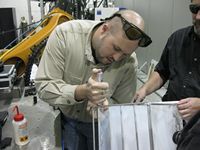 Now my background is software, not hardware and I was a bit dubious that this would all work. The NSS team was confident, of course, as was Ben. For me, it was a case of ‘wait and see’. I’m happy to say that, outside of a small leak, the system performed flawlessly and, as a bonus, produced some of the coolest images I’ve seen. I’ve got video showing the acetone merrily boiling away, doing its thing and I’ll be posting these videos soon. So Test 2 – pass.
Now my background is software, not hardware and I was a bit dubious that this would all work. The NSS team was confident, of course, as was Ben. For me, it was a case of ‘wait and see’. I’m happy to say that, outside of a small leak, the system performed flawlessly and, as a bonus, produced some of the coolest images I’ve seen. I’ve got video showing the acetone merrily boiling away, doing its thing and I’ll be posting these videos soon. So Test 2 – pass.
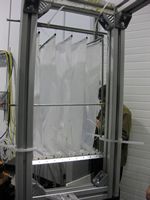 The third and final test scheduled for the day was the one where we tried to melt the Optics; i.e. making sure that the NSS Optical system could also handle the full power load expected during the climb. The results here were much more ambiguous. When the system was turned on, about a minute or so into the test, the NSS team became a bit worried about the smell they detected, coming from their optics, and they had TRUMPF shut down the laser. They quickly determined that the laser beam entering their lens was wider than expected was and was spilling over onto (and melting) the ‘bumpers’ that were holding their lens in place. Discussions with TRUMPF personnel then ensued. It was quickly determined that instead of handing a 200 micron-sized beam to the NSS optics (which NSS was expecting), TRUMPF was sending them a 600 micro-sized beam. NSS believed that this might have been the source of the problem. TRUMPF didn’t believe so, but did change their side of the system so that they were sending out a 200 micron beam. The test was repeated but the results were the same; i.e. the beam was wider at the lens than expected.
The third and final test scheduled for the day was the one where we tried to melt the Optics; i.e. making sure that the NSS Optical system could also handle the full power load expected during the climb. The results here were much more ambiguous. When the system was turned on, about a minute or so into the test, the NSS team became a bit worried about the smell they detected, coming from their optics, and they had TRUMPF shut down the laser. They quickly determined that the laser beam entering their lens was wider than expected was and was spilling over onto (and melting) the ‘bumpers’ that were holding their lens in place. Discussions with TRUMPF personnel then ensued. It was quickly determined that instead of handing a 200 micron-sized beam to the NSS optics (which NSS was expecting), TRUMPF was sending them a 600 micro-sized beam. NSS believed that this might have been the source of the problem. TRUMPF didn’t believe so, but did change their side of the system so that they were sending out a 200 micron beam. The test was repeated but the results were the same; i.e. the beam was wider at the lens than expected.
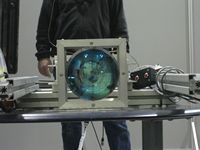 Then the real trouble-shooting started – lots of fun discussions about what possibly might have been the cause. I got involved in these discussions, even though I know squat about lasers, because I do understand debugging and troubleshooting. It seemed to me that there should be some easy way to ‘qualify’ the beam; i.e. to make sure that it was the size and power that TRUMPF team said that the beam was generating could be independently verified. A test like this would quickly determine whether the source of the problem was on the TRUMPF side or the NSS side. Alas, there doesn’t seem to be any such device. However, I gave the idea of this device to TRUMPF and claim patent rights when they finally build one.
Then the real trouble-shooting started – lots of fun discussions about what possibly might have been the cause. I got involved in these discussions, even though I know squat about lasers, because I do understand debugging and troubleshooting. It seemed to me that there should be some easy way to ‘qualify’ the beam; i.e. to make sure that it was the size and power that TRUMPF team said that the beam was generating could be independently verified. A test like this would quickly determine whether the source of the problem was on the TRUMPF side or the NSS side. Alas, there doesn’t seem to be any such device. However, I gave the idea of this device to TRUMPF and claim patent rights when they finally build one.
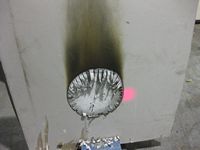 Lacking a way to quickly determine where the souce of the problem was, and still wanting to be able to qualify their optics, NSS built a temporary baffle so that they constrict the beam into the diameter size that their lens was ‘expecting’. The test was then repeated. All seemed to work well for the first several minutes and, as a bonus, resulted in more uber-cool photos and videos. About 6-7 minutes into the test, however, the TRUMPF system reset, killing the laser beam. More discussions and trouble-shooting ensued and the upshot was that the TRUMPF system was recycled and the test was repeated. The results were the same; i.e. several minutes into the test the TRUMPF system was reset, killing the laser. A fault / error-message was detected in the laser feed driving the test. TRUMPF then loosed their more senior technical personnel onto the laser. We won’t know until Tuesday morning what they found and corrected, but they did say, preliminarily, that perhaps their laser WAS generating a beam that was out of specifications.
Lacking a way to quickly determine where the souce of the problem was, and still wanting to be able to qualify their optics, NSS built a temporary baffle so that they constrict the beam into the diameter size that their lens was ‘expecting’. The test was then repeated. All seemed to work well for the first several minutes and, as a bonus, resulted in more uber-cool photos and videos. About 6-7 minutes into the test, however, the TRUMPF system reset, killing the laser beam. More discussions and trouble-shooting ensued and the upshot was that the TRUMPF system was recycled and the test was repeated. The results were the same; i.e. several minutes into the test the TRUMPF system was reset, killing the laser. A fault / error-message was detected in the laser feed driving the test. TRUMPF then loosed their more senior technical personnel onto the laser. We won’t know until Tuesday morning what they found and corrected, but they did say, preliminarily, that perhaps their laser WAS generating a beam that was out of specifications.
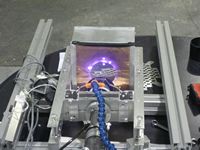 Assuming the TRUMFP personnel can fix their laser feed, we’ll rerun the test on Tuesday morning. The NSS optics have already performed at an acceptable level for a time period longer than a 5 meter/second run will take and have now been provisionally been qualified for the competition. However, no one, not NSS, not Ben or John and certainly not TRUMPF are happy with the situation and want to rerun everything with a correctly functioning laser-feed. This test will be rerun as soon as possible.
Assuming the TRUMFP personnel can fix their laser feed, we’ll rerun the test on Tuesday morning. The NSS optics have already performed at an acceptable level for a time period longer than a 5 meter/second run will take and have now been provisionally been qualified for the competition. However, no one, not NSS, not Ben or John and certainly not TRUMPF are happy with the situation and want to rerun everything with a correctly functioning laser-feed. This test will be rerun as soon as possible.
On Tuesday, then, the schedule is to first try and rerun the “Optics melt test” to everyone’s satisfaction. Once that is completed (or is determined to be not possible at this time), then the Tracking test will be run. We’ll all head out to a location that TRUMPF has set up and we’ll see how well the NSS Manual tracking system performs.
Stay tuned – follow us on Twitter today for up-to-the-minute updates at http://www.twitter.com/segames.
I’ve posted some photos here too, for everyone’s viewing. The first (topmost) photo is of the bottom of the NSS Climber. This climber is easily the smallest of the Climbers in this competition and is on order of the same weight as the Kansas City Space Pirates Climber.
The second photo is an ants view of the bottom of the climber – the climber (mounted on the aluminum rack) being held aloft by the forklift. I had to lie down on the floor to get this shot – the things I do for this blog 🙂
The third photo shows NSS Team member Aaron holding a shot glass used for measuring the amount of acetone injected into their Climber’s cooling system. I can assure everyone that the shotglass was used only for acetone and not anything else (at least while they were onsite)…
Photo #4 shows the NSS Mirror with the cover removed.
Photo #5 shows Aaron injecting the acetone into the NSS Climber’s cooling system. They need to do this just before the runs because the acetone does soak into / eat into some of the cooling system material.
Photo #6 shows a side view of the NSS Climber. The cooling system bags are held in place by an aluminum frame, as you can see. I still can’t get over how well it all seems to work…
Photo#7 is the target’s view of the business end of the NSS Optical system.
Photo #8 is a gypsum board after being scorched by the TRUMPF laser and NSS Optics. Kind of looks like Don King with bangs, no?
And finally, photo #9 shows a top view of the NSS optics while the full-power test was taking place. You can clearly see the laser reflecting off the temporary baffle that the NSS Team members put into place to constrict the beam. With this camera, the laser-reflections are blue. In my video camera, the laser reflections are orange.
I’ll be posting more photos and videos soon.
As always, you can click on any of the picture thumbnails to see a full-size version of the picture.
(In my original post, I mis-identified NSS Team Member “Aaron” as “Eric” – sorry Aaron!)
 The 3rd annual EuroSpaceward conference is now underway. I’m fortunate to have wireless access (at USD 30.00 per day!) during the conference so can blog during the conference.
The 3rd annual EuroSpaceward conference is now underway. I’m fortunate to have wireless access (at USD 30.00 per day!) during the conference so can blog during the conference.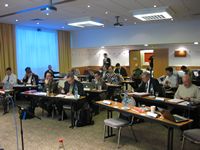 Space Elevators are a key part of this conference but by no means the only topic which will be discussed.
Space Elevators are a key part of this conference but by no means the only topic which will be discussed.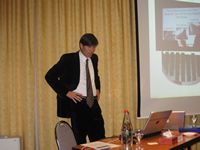 The second picture is of Markus Klettner, Executive Director of EuroSpaceward, giving the opening Welcome address to the attendees.
The second picture is of Markus Klettner, Executive Director of EuroSpaceward, giving the opening Welcome address to the attendees.
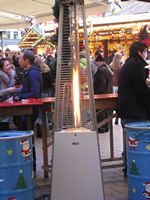

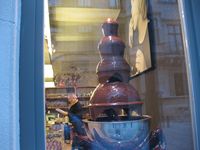


 Sander Olson of the Next Big Future kindly emailed me to let me know that
Sander Olson of the Next Big Future kindly emailed me to let me know that 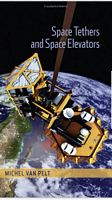
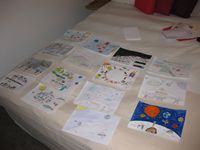
 The picture thumbnail shows several of the drawings I have to judge (click on the thumbnail to see a full size version). I have until Friday, noon, to make my decision.
The picture thumbnail shows several of the drawings I have to judge (click on the thumbnail to see a full size version). I have until Friday, noon, to make my decision. In the many years since the concept of a Space Elevator has been popularized and advanced in Science Fiction, the number of people actively supporting this concept has not appreciably increased. In addition, the theoretical and practical boundaries on the strength of carbon nanotubes are beginning to point towards a material weaker than hoped for (but still strong enough to build a Space Elevator, albeit with reduced capacity). Given these facts, how do those of us in the Space Elevator community move this idea forward?
In the many years since the concept of a Space Elevator has been popularized and advanced in Science Fiction, the number of people actively supporting this concept has not appreciably increased. In addition, the theoretical and practical boundaries on the strength of carbon nanotubes are beginning to point towards a material weaker than hoped for (but still strong enough to build a Space Elevator, albeit with reduced capacity). Given these facts, how do those of us in the Space Elevator community move this idea forward? On the LaserMotive Blog,
On the LaserMotive Blog, 
 Money quote (which occurred after their prize-winning runs on day 1) #1: ‘Waiting just a moment, Steve Beland requested clearance from Test Operations for the Team to begin breathing again. Test granted the request, but for “shallow breaths only”.’
Money quote (which occurred after their prize-winning runs on day 1) #1: ‘Waiting just a moment, Steve Beland requested clearance from Test Operations for the Team to begin breathing again. Test granted the request, but for “shallow breaths only”.’ On the first day of the recently completed Space Elevator Games, there were several reporters and cameras (still and video) at the ISF (the conference center where Bryan and I did the first two days of live coverage of the Games over uStream).
On the first day of the recently completed Space Elevator Games, there were several reporters and cameras (still and video) at the ISF (the conference center where Bryan and I did the first two days of live coverage of the Games over uStream).
 On Tuesday, November 17th, at 4:30pm (Eastern time), members of the 2009 Space Elevator Games prize-winning
On Tuesday, November 17th, at 4:30pm (Eastern time), members of the 2009 Space Elevator Games prize-winning  In
In 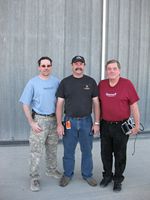
 Time to start giving thanks where thanks are due. There were many, many people and organizations who’s help was crucial to the success of the recently completed Space Elevator Games.
Time to start giving thanks where thanks are due. There were many, many people and organizations who’s help was crucial to the success of the recently completed Space Elevator Games.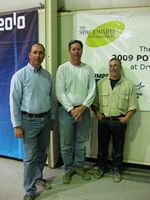
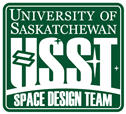 Mark Boots, one of the captains of the
Mark Boots, one of the captains of the 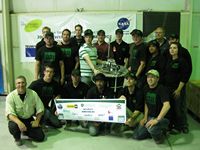
 Brian Turner, captain of the
Brian Turner, captain of the 
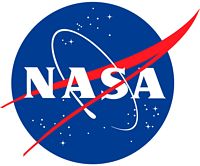 NASA turned the Awards Ceremony into a full-blown presentation, complete with speeches, media coverage and, of course, the awarding of the $900,000 prize to Team LaserMotive. This ceremony was held in the hanger / machine shop that was the team headquarters throughout the competition (and throughout the testing).
NASA turned the Awards Ceremony into a full-blown presentation, complete with speeches, media coverage and, of course, the awarding of the $900,000 prize to Team LaserMotive. This ceremony was held in the hanger / machine shop that was the team headquarters throughout the competition (and throughout the testing).






 And
And 


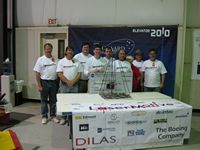
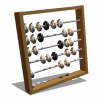 So, if you have climbers of different weights carrying different payloads and having different times to complete the run, how do you come up with a fair way to judge who the winner is?
So, if you have climbers of different weights carrying different payloads and having different times to complete the run, how do you come up with a fair way to judge who the winner is?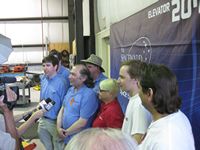

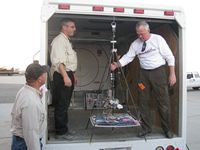

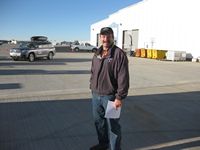
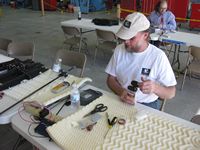
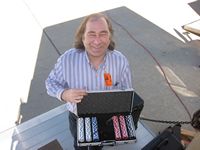
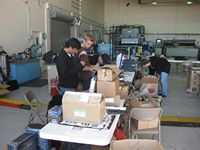

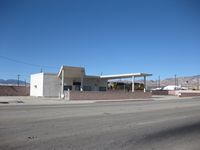

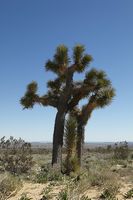
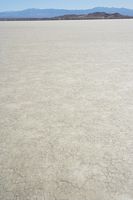
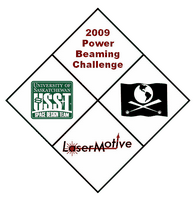 So we’re down to three teams; the Kansas City Space Pirates, Team LaserMotive and USST. In his latest post, Ben describes them as the “robotic club hobbyists”, the ‘industry team’ and the ‘university student team’ respectively. There’s nothing amateurish about any of them – they’re all highly skilled, very motivated and very ready. Barring unforeseen weirdness, we should see numerous prize-winning capable runs.
So we’re down to three teams; the Kansas City Space Pirates, Team LaserMotive and USST. In his latest post, Ben describes them as the “robotic club hobbyists”, the ‘industry team’ and the ‘university student team’ respectively. There’s nothing amateurish about any of them – they’re all highly skilled, very motivated and very ready. Barring unforeseen weirdness, we should see numerous prize-winning capable runs. 
 We are all happy and breathing easier now and I’m thrilled and proud to have a grandson. I turned 60 a couple of months ago and now I have a grand-child. I guess this makes it official – I’m getting old…
We are all happy and breathing easier now and I’m thrilled and proud to have a grandson. I turned 60 a couple of months ago and now I have a grand-child. I guess this makes it official – I’m getting old…
